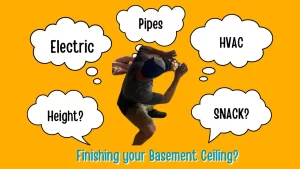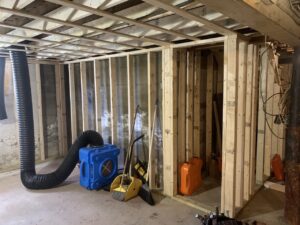Vinyl Plank Vs. Hardwoods Vs. Tile Vs. Carpet
When it comes to remodeling your basement, choosing the right floor for your family sets the tone for how you plan on using the space long term. When considering the type of flooring you will install in your basement, think long and hard about what the initial and long term cost are.
Below are some advantages and disadvantages of each type of flooring you can install in your basement and we are listing them here so you can make the best informed decision on your own terms and not have someone tell you what type of flooring you should use.
Hardwoods
Hardwoods offer rare beauty that cannot be matched. However, traditional flooring installations are not acceptable when it comes to putting hardwoods in your basement. For example, most hardwoods above grade (first floor and above) can be installed with a vapor barrier and nailed directly into a 3/4 inch subfloor.
PROS-
- Looks beautiful
- Many selections including exotic woods
- More natural look that can mostly not be matched
- Requires some maintenance
CONS
- Does not hold up to kids and pets well
- The most expensive to install
- Concrete slab must be sealed
- Ventilation below the hardwoods with a product like DRICORE is recommended to avoid cupping
- Does very poorly with high moisture areas like a slab
- Scratches very easily. Not recommended with areas were kids are expected to play and high traffic.
- Difficult to warranty direct to slab by most pro contractors
Tile
Tile, has traditionally been the go to for basement flooring. Installing tile direct to a concrete slab was often the easiest way to finish the floor In basement locations, porcelain or ceramic tile is generally glued down to the cement subfloor using the same thin-set adhesives used to apply tile to the cement-board underlayment used over plywood or OSB subfloors.
PROS
- Lots of aesthetic options including faux wood plank looks to have the look of real wood
- Strong materials-often difficult to break and handles wet applications very well
- Often very little prep needed to install to the concrete slab. New applications require a rolled mat to create a proper substrate such as a ditra mat.
- Typically does not scratch easily
CONS
- Often expensive to install as it takes a lot of physical labor and prep to install.
- Tile ranges from 3-10 per square foot for basement floors on average without labor or prep materials included
- When damaged, requires breaking the entire piece to replace
- Requires self leveler if the slab is very out of level which is very common in older homes
- Extended lead time on special order tile
Carpet
Carpet has really come a long way from its humble beginnings and is still used in many applications throughout the home including the basement. Using Carpet does require some additional consideration but is a great choice when it comes to overall warmth and comfort. Make sure that you use synthetic padding and have carpet with some synthetic fiber as it will allow for the moisture to be released and prevent long term mold.
PROS
- Easier to install. Often available at under 15-20 per yard. ( a yard is about a 9×9 area)
- Easy way to finish staircases
- Comfortable for kids and pets
- Ideal for young families with small children
- Relatively cheaper to install than other flooring options
- Can be done within a day on most applications
- Good option if basement is relatively dry
- Stains easily depending on color
CONS
- Horrible for basements that deal with high humidity issues
- When damaged or stained, difficult to replace a small area
- Difficult to repair with flooding
- Can hold dust mites and various allergens
- Limited selections when installing direct to a basement slab
Vinyl Plank
Vinyl plank flooring is compared to the others, a fairly new product. Vinyl plank comes in many options with glue down or “floating” installs and has a variety of aesthetic selections to pick from. Often used in basements, vinyl flooring is 100% waterproof and typically has a pre installed backer that allows you to install direct to a concrete slab.
PROS
- Easy to install and often can be done DIY or when hiring a Pro, very little labor is needed to install.
- Many color and style options including wood or tile looking materials.
- Can be used in bathrooms
- Can be used in mud area entries
- Can handle high moisture areas
- Requires no prep to slab
- Pre attached underlayment on better quality Vinyls
- Reasonable labor or DIY option
- Readily available at most big box stores
- Little to no scratching. Great for pets. Does not stain
CONS
- Cold to the touch
- Hard on the feet like tile
- Repairs can take multiple rows removed to get to one board
So there you have it. Those are our pros and cons for some of the most highly used flooring options in a basement. Thinking of have your basement remodeled or just have questions? Please visit our contact us page to get started on your next basement project.
And as always, check out these other great resource articles when it comes to remodeling your basement…

Basement Bathroom Installation: Options to Fit Your Space and Budget
Are you thinking about adding a bathroom to your basement but unsure where to start? At RenoVista Construction, we’ve helped many homeowners navigate this process.

How to Finish a Basement Ceiling: Ensuring Access and Functionality
Finishing a basement is a fantastic way to expand your living space and increase your home’s value. However, a critical aspect often overlooked during basement

Effective Dust Management During Construction Projects
If you’ve ever been involved in a construction or home renovation project, you’re likely all too familiar with the omnipresence of dust. It has an

